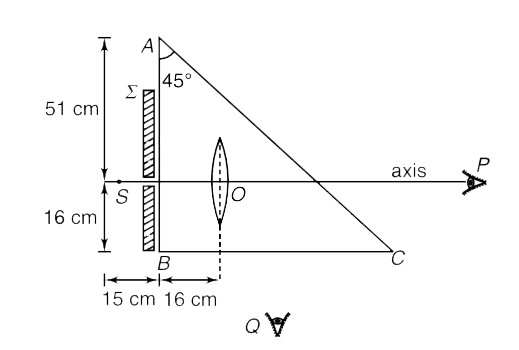An isosceles right angled triangular glass (μ=1.6) prism has a cavity inside it in the shape of a thin convex lens whose both surfaces have radius of curvature equal to 20 cm. The cavity has been filled with a transparent liquid of refractive index 2.4. S is a point source and σ is an opaque sheet having a small hole such that the source and the hole both lie on the principal axis of the lens. The small hole in the opaque sheet is just to ensure that only paraxial rays are incident on the optical system. However, the size of hole is large enough to neglect diffraction effects. Will the observers at P and Q be able to see the image of source S? Where is the image located?

The correct Answer is:Observer at Q sees the image at a distance 6.88 cm from face BC, inside the prism
Step by step video, text & image solution for An isosceles right angled triangular glass (mu = 1.6) prism has a cavity inside it in the shape of a thin convex lens whose both surfaces have radius of curvature equal to 20 cm. The cavity has been filled with a transparent liquid of refractive index 2.4. S is a point source and sigma is an opaque sheet having a small hole such that the source and the hole both lie on the principal axis of the lens. The small hole in the opaque sheet is just to ensure that only paraxial rays are incident on the optical system. However, the size of hole is large enough to neglect diffraction effects. Will the observers at P and Q be able to see the image of source S? Where is the image located? by Physics experts to help you in doubts & scoring excellent marks in Class 12 exams.
Topper's Solved these Questions
Similar Questions
A double convex thin lens made of the refractive index 1.6 has radii of curvature 15 cm each. What is the focal length (in cm) of this les when immersed in a fluid of refractive index 1.63?
View SolutionA double convex thin lens made of glass of refractive index 1.6 has radii of curvature 15 cm each. The focal length of this lens when immersed in a liquid of refractive index 1.63 is :
View Solution
Knowledge Check
- Question 1 - Select One
A plano-convex lens has refractive index 1.6 and radius of curvature 60 cm. What is the focal length of the lens?
A50 cmB100 cmC200 cmD150 cm - Question 2 - Select One or More
A thin concavo-convex lens ha two surface of radii of curvature R and 2R. The mateial of the lens has a refractive index μ. When kept in air, the focal length of the lens
Awil depend on the direction from which light is incident on itBwill be the same, irrespective of the direction from which light is incident on itCwill be equal to Rμ−1Dwill be equal to 2Rμ−1 - Question 3 - Select One
A double convex thin lens made of the refractive index 1.6 has radii of curvature 15 cm each. The focal length of this lens when immersed in a fluid of refractive index 1.63, is
A25 cmB125 cmC250 cmD−407.5cm
A concave lens of glass, refractive index 1.5, has both surface of same radius of curvature R. On immersion in a medium of refractive index 1.75, it will have as a
View SolutionA concave lens of glass, refractive index 1.5 has both surfaces of same radius of curvature R. On immersion in a medium of refractive index 1.75, it will behave as a
View SolutionA concave lens of glass, refractive index 1.5, has both surfaces of same radius of curvature R. On immersion in a medium of refractive index 1.75, it will behave as a
View SolutionThere is a thin double convex lens having surfaces of radius of curvature R and 2R. Lens is kept in air and refractive index of the material of the lens is μ. Focal length of the lens
View SolutionA double convex lens has two surfaces of equal radii R and refractive index m=1.5, we have
View Solution

